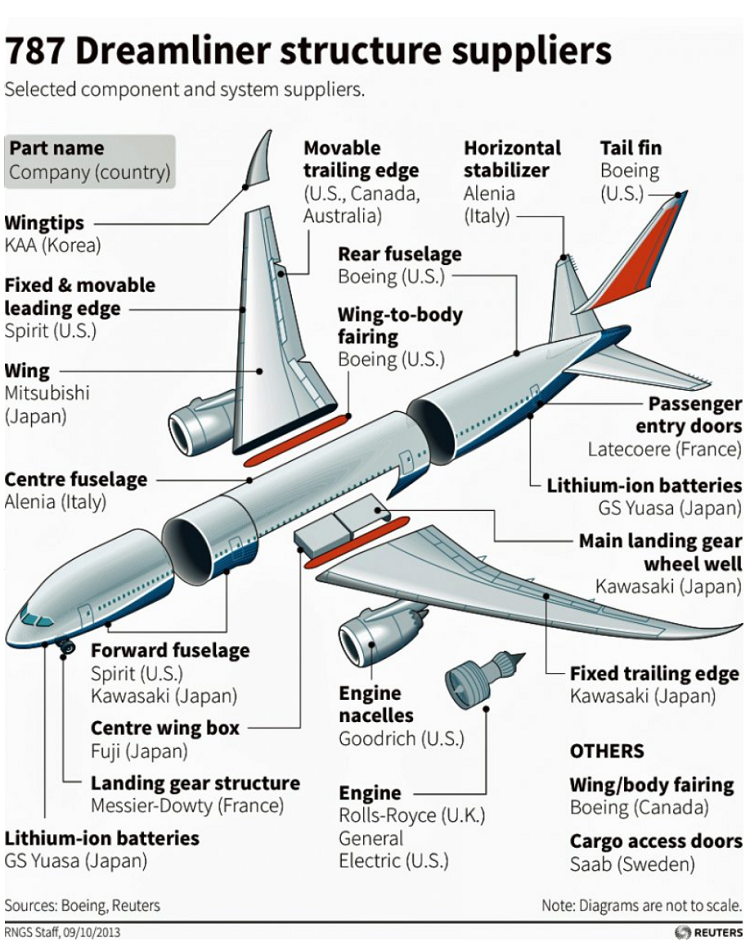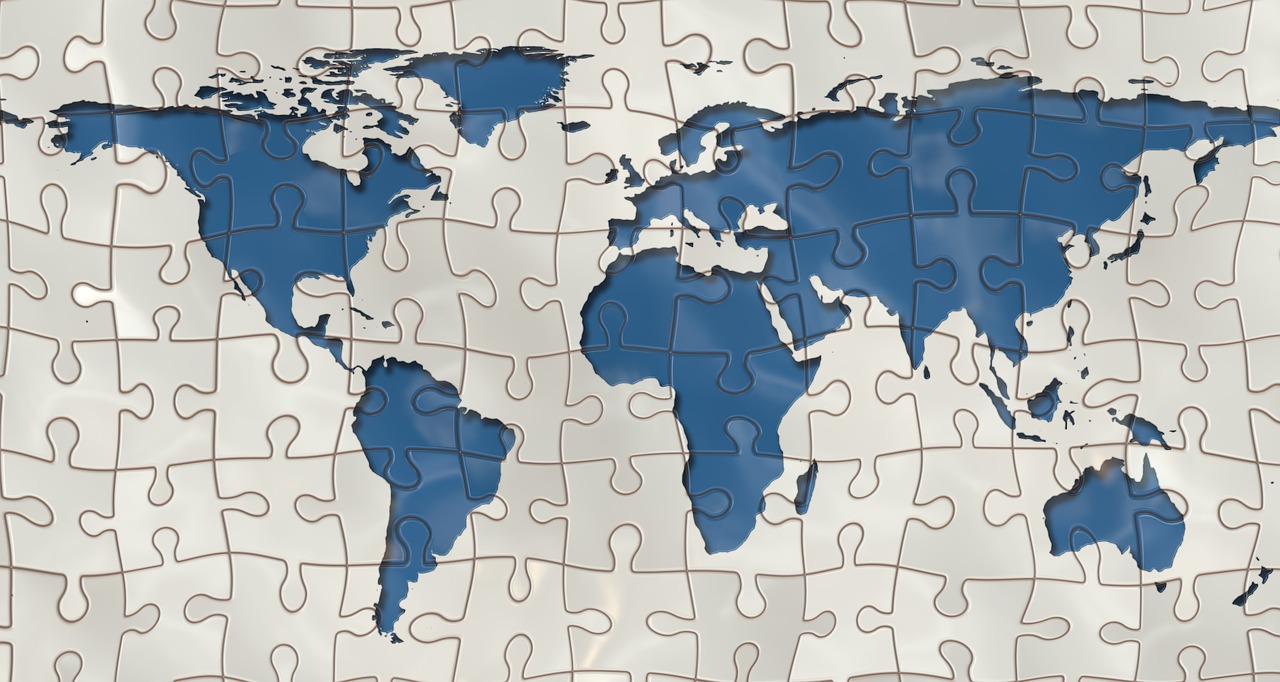It's a Small World After All
Connecting the Dots
MINDS ON
Six Degrees of Separation...or Less?
Have you ever considered what a small world it truly is? Why does the political stability of a country on the other side of the world affect me?
Consider the building of an airplane. Parts and materials come from a number of countries, all over the world. Problems in one country can impact the development of products in another.

Interdependence

Interdependence: Dependence of entities such as people or countries on each other. Canada's interdependence on other countries for imports and exports has grown to record levels because Canada is a trading nation.
Considering interdependence and how some systems depend on others, do you know a honey bee matters to your future?
The following video helps explain the connections between bees and other systems:
bees
ACTION
Interdependence is All About Relationships
At one time, international business looked upon the world as a series of nations and concerned itself only with occasional interactions with other nations. Today, we know that an understanding of interdependence is crucial to success in international business.

Interdependence results because of something called Specialization. Basically, this means that countries (and companies and people) can benefit by specializing in the production of the things they are best at, and then trade in order to obtain other goods that they want. If a country is better at producing something than another country, we say that they have an Absolute Advantage in the production of that good.
If a country’s resources are better suited to the production of some goods than others and they have a lower opportunity cost (what a country needs to give up in order to produce something else) then we say they have a comparative advantage in the production of that good. If a country has a comparative advantage, then they will benefit from producing that good and trading it for a good in which they do not have a comparative advantage.
These economic concepts are explained in the video below:
Interdependence means the mutual dependence of countries on each other. It has become an increasingly critical issue with the growth of globalization:
- Trade barriers have been gradually reduced around the world, as have restrictions of the flow of investment capital between countries.
- There have been dramatic improvements in information and communication technologies, and an increase in the sharing of this technology.
- Methods of transportation have improved, making it easier for people to travel and move products.
- There has been an increase in the number and size of multinational organizations and international organizations.
An Illustration of Independence
As national economies become increasingly integrated through global trade, the economic growth of any given nation becomes increasingly dependent on the economic welfare of its trade partners. International trade has a direct impact on people and businesses both in Canada and around the world. Watch this video which outlines how the production of a simple product - a pencil - is incredibly dependent on countless other items in the free market economy.
Canada’s Industries
Just as countries are dependent on one another, so are countries and people. There are three main types of industries comprised of businesses that are interdependent on one another through a complex system of supply chains.
Primary Industries take raw materials from nature, process them slightly, and sell them to other businesses that use them to make other products or provide services. Canada has an abundance of natural resources. Primary industries have played an important role in our economic history, and continue to be important today.
Secondary Industries include both processing and fabrication types of manufacturing. Grinding wheat into crude flour is an example of processing. A company then refines and enriches that flour through a fabrication process to create a manufactured good. Although manufacturing’s role in our economy has declined, it still represents a large portion of Canada’s GDP, and there has been a recent surge in growth in the primary manufacturing industries (2016, Statistics Canada).
Tertiary Industries provide services to their customers. They do not sell tangible items - although rental services allow customers to use tangible items for a period of time. Services provide intangibles that people need or want and are often activities performed by experts who can do what untrained people cannot. Services play a very important role in Canada’s economy, with services comprising almost three-quarters of our GDP (Gross Domestic Product) and 4 out of 5 of Canada’s jobs. Service sectors are more knowledge-intensive than other sectors and therefore employ more well-educated workers than other industries.
The three interactives below will help you become familiar with the three industries, as well as the goods and services related to each one:
industriesPrim
industriesSec
industriesTert
The Import-Export Connection
Imports are goods or services that are brought in from another country. Exports are goods or services that are sent to another country for sale. The import-export landscape is changing dramatically because of the growth in emerging markets and changes in the relative price of goods and services (Globe & Mail, 2013).
 Import/Export
Import/Export
Identify one of Canada’s top imports OR exports.
Research this import or export and explain:
- The industry sector the good or service falls under.
- How Canada’s trade of this good or service has changed over the course of the past 20 years and why.
- Include the website(s) where you obtained your information.
Exploring Canada’s Major Trade Relationships
The U.S. has been Canada’s largest trading partner since the relationship was established in the late 1800s, but we are becoming less reliant on the U.S. because of new markets that are emerging.
 Canada’s Trade Partners
Canada’s Trade Partners
Use the interactive map below to learn about Canada’s Trade Partners
1. Research the names of Canada’s top 10 merchandise import partners.
2. Highlight these countries on the map below.
3. Take a screenshot of the resulting map.
miPartners
1. Research the names of Canada’s top 10 merchandise export partners.
2. Highlight these countries on the map below.
3. Take a screenshot of the resulting map.
mePartners
1. Research the names of Canada’s top 10 service import partners.
2. Highlight these countries on the map below.
3. Take a screenshot of the resulting map.
siPartners
1. Research the names of Canada’s top 10 service export partners.
2. Highlight these countries on the map below.
3. Take a screenshot of the resulting map.
sePartners
U.S.A. is still Number One
Let’s take a closer look at Canada’s main trading partner - the United States.
The Canada-US two-way partnership is the largest bilateral trading relationship (the exchange of goods and services between two countries with a focus on reducing trade barriers) in the world. More than 75% of Canada’s merchandise exports and more than 50% of Canada’s service exports go to the United States. Canada is also the largest export market for the United States, accounting for $266 billion in U.S. merchandise exports and $54.2 billion in U.S. service exports. The U.S. is by far Canada’s largest source of direct investment and debt capital, and the largest destination for Canadian investment abroad. In many years, Canada has reported a merchandise trade surplus with the U.S., with exports of natural resources offsetting the imports of manufactured goods.
Shared infrastructure has furthered economic relations between Canada and the United States. The St. Lawrence Seaway provides access to both U.S. and Canadian ports on the Great Lakes. The nations have shared in the building and operation of dams for electrical power and flood control. The two countries are closely linked through oil and gas pipelines, railways, highways, electricity grids, and telecommunication networks.
Establishing and strengthening this relationship has been a key Canadian goal since Confederation. Canada’s economic health is dependent on our bond with the U.S. However, because of the difference in size and power between the two countries, it is fraught with risk. U.S. actions have a great potential impact on Canada, but Canadian actions have little impact on the U.S.
“
To live alongside this great nation is like living with your wife. At times it is difficult to live with her. At all times, it is impossible to live without her.
~ Prime Minister Lester Pearson
This vulnerability was never more evident than in the aftermath of the terrorist attacks on September 11, 2011. The U.S. instituted lengthy border delays, placing greater importance on security than trade, threatening supplier relationships and delivery times. In response, Canada was forced to make significant investments in border security in order to address US security concerns.
Canada and the United States have evolved together from rural to industrial to knowledge-based economies. Globalization, technological changes, shifts in demand for natural resources, and environmental challenges continue to unite us.
While Canadians and Americans share many fundamental values, there are some important differences. Take a look at this comparison between the two countries. Select each characteristic to examine the similarities and differences.
| Canada | United States | |
|---|---|---|
|
|
||
| 9.985 million km2 | Total Land Size | 9.834 million km2 |
|
Appalachian Mountains
|
Major Landform Regions |
Appalachian Mountains
|
| 10 provinces and 3 territories |
Total States/Provinces |
50 states |
| 5 large freshwater lakes in central North America represent the world’s busiest shipping areas. Most of Canada’s population lives in this region.
The St. Lawrence seaway is a major source of U.S./Canada and overseas shipping and huge producer of hydroelectricity. Atlantic Ocean is major shipping route to Europe and Africa. Pacific Ocean is major shipping route to Asia. Hudson’s Bay is the arm of the Atlantic Ocean transporting goods from western Canada to the Atlantic and onto other countries. |
Bodies of Water | 5 large freshwater lakes in central North America represent the world’s busiest shipping areas. Most of Canada’s population lives in this region.
The St. Lawrence seaway is a major source of U.S./Canada and overseas shipping and huge producer of hydroelectricity. Atlantic Ocean is major shipping route to Europe and Africa. Pacific Ocean is major shipping route to Asia. Gulf Coast provides easy access to the southeast |
|
|
||
| US$43,249 (2015) | Total GDP per capita | US$55,837 (2015) |
| Canadian Dollar | Type of Currency | U.S. Dollar |
| Vehicles
Machinery including computers Electrical machinery and equipment Mineral fuels including oil Plastics and Plastic articles |
Major Imports | Electrical machinery and equipment
Machinery including computers Vehicles Mineral fuels including oil Pharmaceuticals |
|
|
||
| Parliamentary Democracy, where law is the supreme authority.
Constitutional Monarchy, which means that executive power is vested in the Queen through the Constitution. Canadians tend to see government as a positive force in the economy, hence the willingness to use public policy tools, including Crown Corporations, to meet Canadian needs. |
Type of Government | Federal Republic Government, where power is divided between two levels of sovereignty: the national government and the states.
The strict separation of powers in the U.S. is based on a greater distrust of government. |
| The Prime Minister is chosen by the governor general, and is usually the leader of the political party with the most members in the House of Commons.
Canada follows the British Parliamentary system of government. We vote directly for a Member of Parliament. The highest number of votes in a geographical riding gives the winning member a seat in the House of Commons. |
How is government chosen? | The President is elected by a nationwide vote for a term of four years. Americans cast their vote directly for a Representative, Senator, and President/Vice-President. |
| Ottawa | Name of Capital City | Washington, D.C. |
|
|
||
| 35.85 million (2015) | Total Population | 321.4 million (2015) |
| 81.96 years (2014) | Life Expectancy | 78.94 years (2014) |
| The largest numbers of Aboriginal peoples live in Ontario and the western provinces (Manitoba, Saskatchewan, Alberta and B.C.) Aboriginal people also make up the largest share of the populations of Nunavut and the Northwest Territories. | Groups of Native Peoples | More than one-third of Native Americans live in three states: California, Arizona, and Oklahoma. |
| French
Spanish Italian German Punjabi Chinese Cantonese Tagalog (Filipino) Arabic Mandarin More than 2 million people speak neither French nor English at home. One-fifth of Canada’s population speaks a foreign language at least some of the time at home. |
Major Languages Spoken | English
Spanish Chinese French/French Creole Tagalog (Filipino) Vietnamese |
Take a look at this video which discusses some of the differences between Canadian and American culture:
Despite their differences, the Canada-U.S. economic relationship has worked to the benefit of both countries, and the maintenance of this relationship will remain the critical challenge for Canada for years to come.
CONSOLIDATION
Vocabulary Self-Check
Match the following terms with their correct definitions in order to assess your understanding of the international business terminology covered so far in the course.
terms2
Why the World is Flat
American newspaper columnist Thomas Friedman has spoken extensively about the spread of Globalization, which he summarizes in his book, "The World is Flat: A Brief History of the Twentieth Century." Friedman says that Globalization is levelling the playing field for businesses, giving all competitors increasingly equal opportunities. He lists 10 Forces (or events) that have served to flatten the world, and enable the continued spread of globalization:
- Collapse of the Berlin Wall
- Netscape
- Workflow Software
- Outsourcing
- Offshoring
- Open Source
- Supply-Chaining
- Insourcing
- Informing
- “The Steroids”
You can read more about these flatteners from Friedman's book.